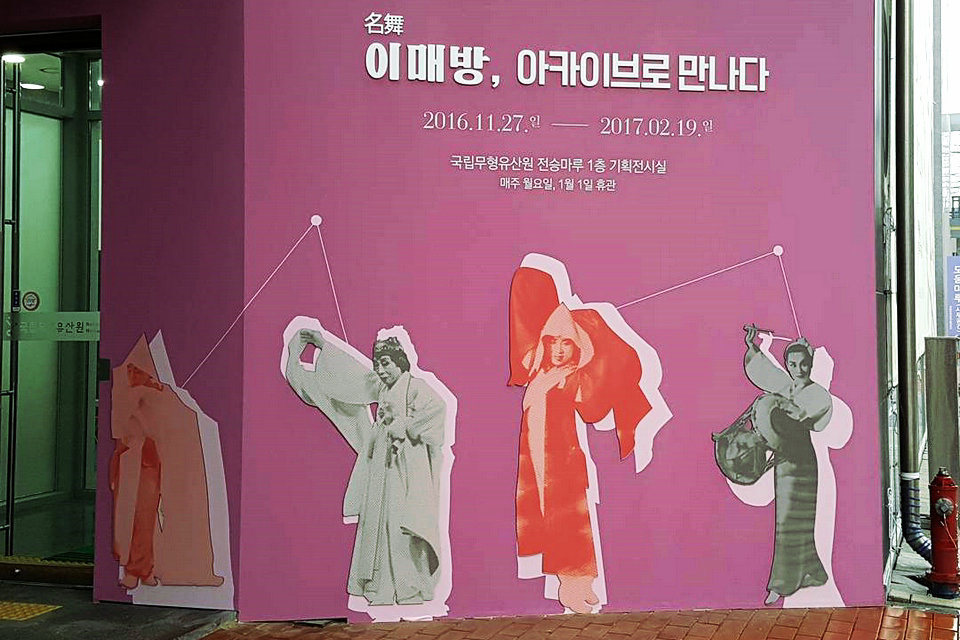Famous dancer, National Intangible Heritage Center, South Korea


The National Intangible Cultural Heritage Institute donates and deposits the collections of intangible cultural heritage folks for the preservation and transmission of intangible cultural heritage and archives them for exhibition and academic research. As the first project, we gathered all the materials that contained the life and philosophy of 故 Woo Bong Lee Mae-bang (李梅芳, 1927 ~ 2015), who has kept our dance for a lifetime.
Lee Mae-bang was a giant that spread the beauty of traditional dance with its innate artistry, and was a human cultural asset in the field of crew and dance. He will showcase his life and art world with his hands-on props he used during his lifetime, as well as his own performance costumes and tools, as well as various photographic and video materials showing his heyday.
This special exhibition will be a valuable time for you to feel the love of the artist’s dance of the age and the joyful life of Y Mae-bang and the artist who has lived for a long time.
Lee Mae-bang, Dance and Life
The young boy who danced with a skirt in front of the grandfather walked out as if he had foreseen to be a tow.
He left, but his passion remained intact. His love for traditional dance is deeply rooted as Lee Mae-bang Ryu, one of the schools of traditional dance, is deeply inherited. In his hometown Mokpo, dance competitions and workshops are held every year to honor his name. There is.
The life of human Maebang can be felt through the records of his many performances, photographs of everyday life, and letters from disciples.
My heart is Kowaya
“The heart is wow, the dance is fine.” Lee Mae- bang spoke to his disciples during his lifetime.
Lee Mae-bang is a human cultural asset that spits out swearing words. It was usually a scary, stubborn teacher, but there was a warmth in which the disciples made their own costumes. The craftsmanship was as delicate and graceful as the dance, and everything was done with his own hands, not just clothes, but anything related to dance.
Those who remember this one say. “It’s safe to dance in the clothes he wears, and it’s relieved that thick swearing comes out of his mouth.”
You can feel his smell in the work space where you collected and reproduced the artifacts on the hands of Imaebang.
I Want To Dance
“I want to dance too.” I whispered as I looked at the stage with my weakened body on a wheelchair.
Even when the veteran’s body climbed on the stage, his bent back was stretched out and his shoulder dance was bowed.
If you want to tell the story of Lee Mae-bang’s life, there is nothing like the ‘dance’ he recreated and created without the editorials. The space where Imaebang dance lived and lived as a dancer for the rest of his life and passed on his dance to numerous disciples. You can feel his passion and artistic warmth in the space filled with the recreated art soul of Lee Mae-bang.
Life is Dance and Dance is Life
Plum blossoms, plum blossoms that have survived the winter season!
The scent of plum blossoms is due to the harsh winters, so Lee Mae-bang’s dance was completed with his lush life, stubbornness and passion.
His dance, emphasizing a fine heart, melted into life and turned into stage art. It was a time that lighted the way with dance, opened the meaning with dance, and burned deity and excitement.
We ask the best passersby who have given their lives to connect the traditional dance and find the direction we should go.
National Intangible Heritage Center, South Korea
National Intangible Heritage Center is in charge of affairs concerning the preservation of intangible cultural heritage, lore, research, investigation, records management, dissemination and promotion seconded Republic of Korea Culture is the institution’s. It was founded on September 17, 2013 and is located at 95 Seohak-ro, Wansan – gu, Jeonju – si, Jeollabuk – do. The director shall be sent to the general civil servants or academic research officers belonging to the senior civil service group B level.
Preserving Tradition, Supporting Artistry, The NIHC strives to consecrate our intangible cultural heritage. A treasure house of tradition and culture, the spirit and soul of Korea, intangible heritage is a record of our country’s cherished past, as well as a vital foundation for future cultural prosperity. Located in the historic city of Jeonju, the National Intangible Heritage Center of Korea strives to preserve intact and discover new ways to enjoy our precious intangible heritage, all as a means to expand its significance within daily lives for generations to come.
Discover, Preserve, Promote, Come and joy Our cultural feast. Striving to establish a body of knowledge through search and research effort. Systematizing the selection and management of intangible heritage, and providing public access to the collection. Establishing a foundation for all levels of education and an effective system for safeguarding Korea’s heritage. Pursuing the popularization and upgrading of performances and showcases for intangible heritage. Offering venues that meet the highest expectations and captivating firsthand experiences.